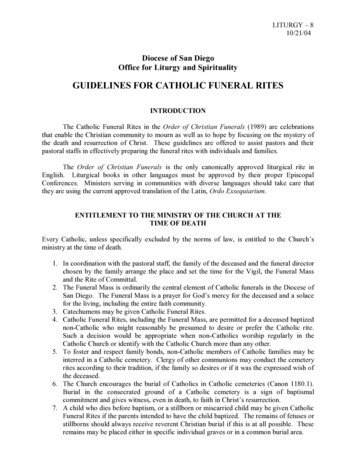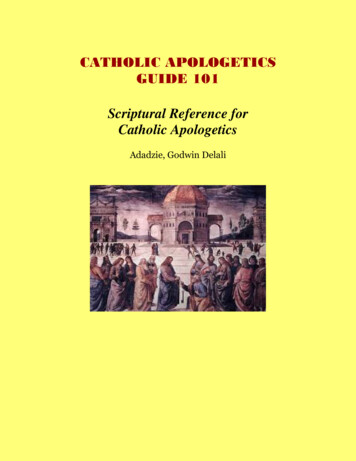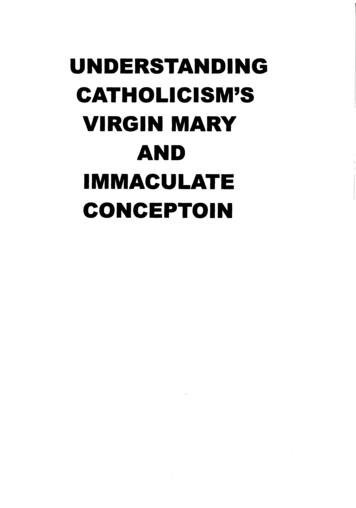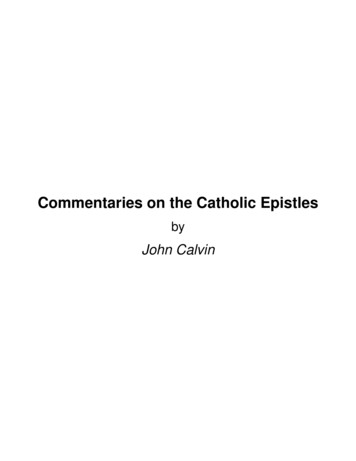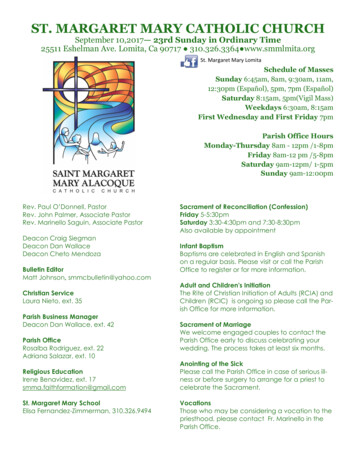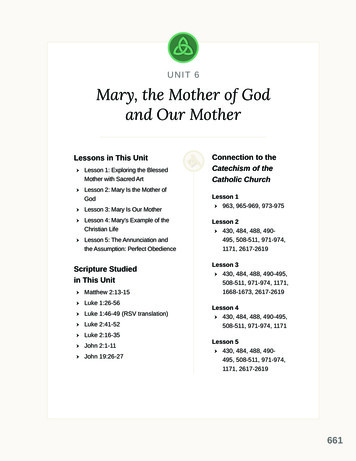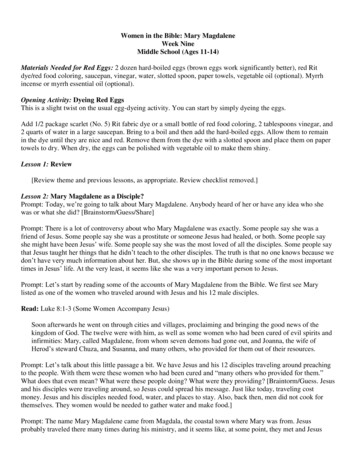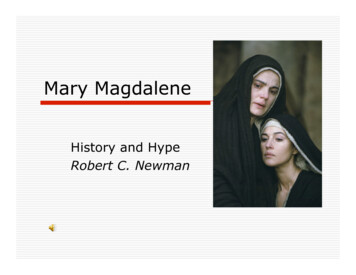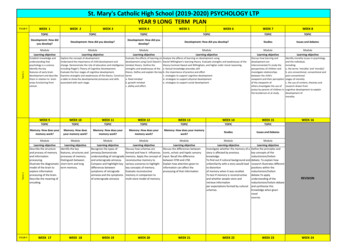
Transcription
St. Mary's Catholic High School (2019-2020) PSYCHOLOGY LTPYEAR 9 LONG TERM PLANYEAR 9WEEK 1WEEK 2Term 1Term 1WEEK 4WEEK 5WEEK 6WEEK 7WEEK 8TOPICTOPICTOPICTOPICTOPICTOPICDevelopment: How didyou develop?Development: How did you develop?Development: How did youdevelop?Development: How did you develop?StudiesIssues and g objectiveYEAR 9WEEK 3Establish knowledge andunderstanding thatpsychology is a science.Identify the keyfeatures of early braindevelopment and describethem in relation to brainareas functioning fromstimuli .Learning objectiveLearning objectiveExplore the concept of development.Understand the importance of child development andchange. Demonstrate the role of education and intelligenceincluding Piaget’s Theory of Cognitive Development.Evaluate the four stages of cognitive development.Examine strengths and weaknesses of the theory. Constructa table to show the developmental processes and skillsassociated with each stage.Evaluate the effects of learning ondevelopment using Carol Dweck’smindset theory. Outline thestrengths and weaknesses of thetheory. Define and explain the keytermsa. fixed mindsetb. growth mindsetc. ability and effort.Learning objectiveLearning objectiveAnalyse the effects of learning on development usingDaniel Willingham’s learning theory. Evaluate strengths and weaknesses of thetheory.Contrast Dweck and Willingham, and higher order moral reasoninga. factual knowledge precedes skillb. the importance of practice and effortc. strategies to support cognitive developmentd. strategies to support physical developmente. strategies to support social developmentDiscuss how learning anddevelopment areinterconnected.To study theperspectives of children andinvestigate relationshipsbetween the child’sviewpoint and their perceptionof the viewpoint ofothers.Investigate the use ofpraise by parents of children inthe Gunderson et al study.WEEK 9WEEK 10WEEK 11WEEK 12WEEK 13WEEK 14WEEK 15TOPICTOPICTOPICTOPICTOPICTOPICTOPICMemory: How does yourmemory work?Memory: How doesyour memory work?Memory: How does yourmemory work?Memory: How does yourmemory work?Memory: How does your memorywork?StudiesIssues and earning objectiveDescribe the structureand process of memoryand informationprocessing.Illustrate the diagramaticmodel of the brain toexplore informationprocessing of the brain.Describe the meaning ofencoding.Learning objectiveIdentify the keyfeatures, structures andprocesses of memory.Distinguish betweenshort term and longterm memory.Learning objectiveRecognize the types ofamnesia.Demonstrateunderstanding of retrogradeand anterograde amnesia.Compare and hightlight keydifferences betweensymptoms of retrogradeamnesia and the symptomsof anterograde amnesiaLearning objectiveDiscuss how schemas areformed and how it influencesmemory. Apply the concept ofreconstuctive memory tovarious scenarios to highlightkey concepts of memory.Evaluate reconstuctivememory in comparison tomulti store model of memory.Learning objectiveInvestigate whether the memory of astory is affected by previousknowledge.To find out if cultural background andunfamiliarity with a story would leadto distortionof memory when it was recalled.To test if memory is reconstructiveand whether people store andretrieve informationper expectations formed by culturalschemas.Learning objectiveDefine the principles andkey concepts of thereductionism/holismdebate. To explain howresearch illustrates differentpositions within thereductionism/holismdebate.To applyunderstanding of thereductionism/holism debateand synthesise thisknowledge when givennovelsourcesWEEK 19WEEK 20WEEK 22WEEK 23WEEK 17WEEK 18Learning objectiveDiscuss the differences betweeniconic, echoic and haptic sensoryinput. Recall the differencebetween STM and LTM.Explain how attention given toinformation can affect theprocessing of that informationWEEK 21Learning objectiveIdentify morality issues in psychologyand the individual,including:a. the terms ‘morality’ and ‘moral(s)’b. pre-conventional, conventional andpost-conventionalstages of moralityc. the use of content, theories andresearch drawn fromcognitive development to explaindevelopment ofmoralityWEEK 16REVISIONWEEK 24
Term 2Term ical ProblemPsyhcological ProblemStudiesIssues and DebatesThe brain and neuropsychology :How does your brain affect youThe brain and neuropsychology :How does your brain affect youThe brain andneuropsychology : Howdoes your brain affect youThe brain and neuropsychology :How does your brain affect eLearning objectiveDevelop and furtherknowledge of commonpsychological disorders.Introspect two majormood disorders:addiction and depression.Use thesymptoms list from ICDas a framework tounderstand whatsymptoms are and whythey are important.Survey elderly relativesaboutshowing changes inknowledge and attitudestowards mentalor physical disorders.Learning objectiveRecognize the symptomsand features of bothdepression andaddiction according tothe ICD.Evaluate cognitivetheory as an explanationof depression,including strengths andweaknesses .Assess learning theory asan explanation ofaddiction can beevaluated throughcomparisons. drugscould be used as atreatment for bothdepression andaddiction.Learning objectiveExplain stressfulexperiences lead todepression in some peoplebut not others.Investigate the role of agene involved withserotonin to see if itcontributed to depression.Write hypotheses forexperimental designexercises undertaken onmemory. Evaluate whetherthere is a genetic basisfor addictive behaviourLearning objectiveDefine the principles and keyconcepts within thenature/nurture debate.Outlinethe key features of thenature/nurture debate.Identify evidence to supporteach side of the debate .Critique the methods used byeach position within thedebate.Learning objectiveDiscuss the differences betweeniconic, echoic and haptic sensoryinput. Recall the differencebetween STM and LTM. Explainhow attention given to informationcan affect the processing of thatinformationLearning objectiveAnalyze the lateralisation of functionin the brain.Describe how lateralisation couldexplain sex differences in males andfemales.Learning objectiveDescribe the relevance ofneuropsychology tomanaging psychologicaldisorders.Explain the physiology ofthe nervous system.Describe the anatomy of thenervous system.Learning objectiveAssess the impact of neurologicaldamage on cognitions and behaviour.Explain key terms visual agnosia andprosopagnosia.WEEK 25WEEK 26WEEK 27WEEK 28WEEK 29WEEK 32WEEK 30WEEK 31TOPICTOPICTOPICTOPICTOPICStudies/Issues andDebatesSocial influences: How do others affect you?Social influenceStudiesIssues anddebatesModuleModuleModuleModuleModuleLearning objectiveLearning objectiveLearning objectiveLearning objectiveLearning objectiveREVISION
Term 2Identify the location ofdamage in Phineas Gageusing modernneuroimagingtechniques. Investigatethe cognitive functionsthat are linked to eachhemisphere in the brain.The experiments aimedto assess thebehavioural, neurologicaland psychological effectsofthe split-brain surgery onthe patients.Define and explain what is meant by a bystandereffect.Distinguish between bystander‘intervention’ and bystander ‘apathy’ .Demonstrateknowledge about various forms of social influence,such as social facilitation, social loafing, conformity,compliance, and obedience.Relate conformity to majority influence and factorsaffecting conformity to majority influence, including:a. personalityb. the situation . Recognize obedience to authority and factorsaffectingobedience to authority figures, including:a. personalityb. the situation. Evaluate the behaviour of crowds and theindividualswithin them and the effect of collective behaviour, includinga. pro- and anti-social behaviour Understand possible ways toprevent blind obedience toauthority figuresInvestigate the effect that the typeof victim would have on the speedand frequency with which someonewould respond to aid them in anemergency. Investigate the effect ofrole model behaviours in emergencysituations and the relationshipbetween the size of the group andhelping a victim.Assess behaviourof ‘normal-average’ people whenassigned the roles of ‘guards’ and‘prisoners’. Analyze changes inemotions, mood,interactions, coping skills andattitudes towards oneself and others.Demonstrate knowledge onsocial and cultural issues inpsychology, including:a. know the terms ‘society’and ‘social issues’b. know the term ‘culture’c. the use of content,theories, and researchdrawn from social influenceto explain social and culturalissues in psychologyREVISIONYEAR 10 LONG TERM PLANYEAR 10WEEK 1WEEK 2WEEK 3WEEK 4WEEK 5WEEK 6WEEK 7WEEK t andrecidivismTreating offendersStudy: Bandura,Ross and Ross(1961)Study: Charlton etal. (2000)Self-concept (Lewis,1990) (Roger's 1959)Humanisticexplanation of theself: Rogers, 1959& 1951, leModuleModuleModule1.Skinner’s OperantConditioning TheoryEysenck’s biological(1948)explanation of2.Bandura’s Socialcriminality (1964)Learning Theory(1977)Term 1ModuleLearning objectiveEvaluate learningtheories as anexplanation ofcriminality, includingstrengths andweaknesses of eachtheory.ModuleLearning objectiveAnalzye biologicalexplanations ofcriminality, includingpersonality types(Eysenck, 1964), toinclude strengths andweaknesses of thetheory.WEEK 9WEEK 10TOPICLearning objectiveUnderstand the effects ofpunishments on recidivism,including strengths andweaknesses of eachpunishment.Learning objectiveExplore two treatments torehabilitate and reducecriminal and antisocialbehaviour and increase prosocial behaviour, includingstrengths and weaknesses ofeach treatment.Learning objectiveBandura, Ross and Ross(1961) study: use APFCframework for descriptionthen evaluate usingstrengths andweaknesses.Charlton et al. (2000)study: use APFC framework fordescriptionthen evaluate usingstrengths andweaknesses.Learning objectiveReview the concepts of the self andself-concept,including:Lewis (1990).Explain the role of identity and freewill in thedevelopment of self, includingstrengths and weaknesses of eachtheory:a. Erikson (1959) the eight stages ofidentity developmentb. Baumeister (2008) theconsequence of belief in free will.Learning objectiveLearning objectiveEvaluate Humanistic Theory Analyze how personality can beof self by: a.Rogers (1951) measured, including:b. Maslow's (1943)a. personality scalesb. personality typesWEEK 11WEEK 12WEEK 13WEEK 14WEEK 15TOPICTOPICTOPICTOPICTOPICWEEK 16
Term 1Term 2Term 2YEAR 10Trait theories ofpersonalityPerceptionGibson’s DirectTheory of Perception(1996)ModuleModuleModuleLearning objectiveEmphasize the use of trait theory as a measure ofpersonality, including strengths and weaknesses oftrait theory:a. Allport (1936) cardinal, central and secondarypersonality traitsb. Cattell (1946) 16PF personality factorassessment.Learning objectiveCreate examples of, andanalyze the reasons for,monocular andbinocular depth cues.Learning objectiveEvaluate the Direct Theory ofPerception (Gibson, 1996) asan explanation of sensationand perception, includingstrengths and weaknesses ofthe theory.Gregory’sConstructivist Theoryof Perception (1970)Perceptual setStudies :1.Haber andLevin (2001)2. Carmichael etal. (1932)ModuleModuleModuleLearning objectiveEvaluate the Constructivist Theoryof Perception (Gregory, 1970) as anexplanation of sensation andperception, includingstrengths and weaknesses of thetheory.Learning objectiveAnalyze the use of set as ameans of understandingand interpreting theworld.Predispositions as a result ofmotivation,expectation, experience,emotion, context andculture.Learning objective1.Evaluate Haber and Levin(2001) The Independence ofSize Perceptionand Distance Perception.2. Evalaute Carmichael,Hogan and Walter (1932) AnExperimental Studyon the Effect of Languageon the Reproduction ofVisuallyPerceived FormREVISIONWEEK 17WEEK 18WEEK 19WEEK 20WEEK 21WEEK 22WEEK 23WEEK al setStudies :1.Haber andLevin (2001)2. Carmichael etal. (1932)Functions of sleepInternal and externalfactors affectingsleepSleep disorders Freud’s theoryofdreaming (1900)Activation Synthesis TheoryStudies: 1. Freud –LittleHans (1909)2. Siffre duleModuleModuleModuleModuleLearning objectiveExplore symptoms and explanationsof sleep disorders, including:a. insomniab. narcolepsy2.Evalaute Freudian theory ofdreaming (Freud, 1900),including strengths and weaknessesof the theory.Learning objectiveEvaluate Activation Synthesis Theory(Hobson and McCarley, 1977),including strengths and weaknessesof the theory.Learning objectiveEvaluate the aims,procedures and findings(results and conclusions),strengths and weaknessesof:1. Freud (1909) Little Hans,analysis of a phobia in a fiveyear old boy.2. Siffre (1975) Six monthsalone in a cave.Learning objectiveOutline the use ofperceptual set as ameans of understandingand interpreting theworld.Predispositions asa result of motivation,expectation, experience,emotion, context andculture.Learning objectiveLearning objective1.Evaluate Haber andAnalyze the functions,Levin (2001) Thefeatures and benefits ofIndependence of Sizesleep.Perception and DistancePerception.2. Evalaute Carmichael,Hogan and Walter (1932)An Experimental Studyon the Effect ofLanguage on theReproduction of VisuallyPerceived FormLearning objectiveDiscuss the internal andexternal influences on sleep,including strengths andweaknesses of eachexplanation.WEEK 25WEEK 26WEEK 27WEEK 28WEEK 29WEEK 30WEEK ghtissuesLanguage structuresand view of theworldAitchison's criteria(1983)understanding non-verbalcommunicationDarwinian view ofnon-verbalcommunicationYuki et oduleModuleModuleLearning objectiveLearning objectiveLearning objectiveLearning objectiveLearning objectiveLearning objectiveLearning objectiveLearning objectiveAnalyze the possible relationshipbetween language and thought,including strengths and weaknessesof eachtheory:a. Piaget’s (1950)b. Vygotsky’s (1981)WEEK 32REVISION
Term 2Analyze the possiblerelationship betweenlanguage andthought, includingstrengths andweaknesses of eachtheory:a.pre-linguistic thoughtb. pre-intellectuallanguageDiscuss how thought andlanguage structuresaffectviews of the world,including strengths andweaknesses ofeach theory:a. linguistic relativismb. linguistic determinism.Explore how communicationis different in humans toanimals, including:a. Aitchison (1983) criteriaof language featuresb. similarities anddifferences betweenhumans and animalcommunication.Explain the examples of nonverbal communication,including:a. facial expressionsb. eye contactc. body languaged. personal space, anddifferences in non-verbalcommunication.Evaluate the explanations of nonverbal communication,including Darwin’s (1872) theory ofevolution.Evaluate the aims, procedures, andfindings (results andconclusions), strengths andweaknesses of:Yuki et al. (2007): Are the windowsto the soul the same inthe East and West? Culturaldifferences in using the eyes andmouth as cues to recognize emotionsin Japan and the United States.Evaluate the aims,procedures, and findings(results andconclusions), strengths andweaknesses of: Boroditsky(2001) Does LanguageShape Thought?:Mandarin and EnglishSpeakers’ Conceptions ofTime.REVISIONYEAR 11 LONG TERM PLANTerm 1YEAR 11WEEK 1WEEK 2WEEK 3WEEK 4WEEK 5WEEK 6WEEK 7WEEK ng VariablesHow to controlExtraneous variablesHypothesisMethods of SamplingExperimental designsRealiabilty and vadidity ofresearch designsEthical issues inpsychological researchTypes of ModuleLearning objectiveIdentify:a. an independentvariable (IV)b. a dependent variable(DV)c. extraneous variables,including(i) situational variables(ii) participant variablesLearning objectiveEvaluate the different methodsof sampling, includingstrengths and weaknesses ofeach sampling methodLearning objectiveExplore the experimental andresearch designs, includingstrengths and weaknesses:a. independent measuresb. repeated measuresc. matched pairsLearning objectiveOutline how reliability and validity isaffected whenanalysing the planning andconducting of researchprocedure.sLearning objectiveAnalyze ethical issues inpsychological research andhow to deal with ethicalissues.WEEK 9WEEK 10WEEK 11WEEK 12WEEK 13WEEK 14WEEK 15TOPICTOPICTOPICTOPICTOPICTOPICTOPICPrimary data vssecondary dataQualitative data vsquantitative dataIssues and debatesIssues and debatesData analysis:Arithmetic andnumericalcomputationTerm 1Learning objectiveLearning objectiveAnalyze the influence of Learn how to write a nullextraneous variables and hypothesis and alternativesuggest possible ways to hypothesis.control for them,including:a. use of standardisedproceduresb. counterbalancingc. randomisationd. single-blindtechniquese. double-blindtechniquesData analysis: Mean Data analysis: constructMode and Medianand eLearning objectiveLearning objectiveLearning objectiveLearning objectiveLearning objectiveLearning objectiveLearning objectiveLearning objectiveEvaluate research methods, includingthe features, strengths andweaknesses of the following, and thetypes of research for which theyare suitable.WEEK 16REVISION
Term 1Term 2YEAR 11Recognise and useexpressions in decimalandstandard formb. estimate resultsc. use an appropriatenumber of significantfiguresAnalyze and use,including calculations:a. mean, and findingarithmetic meansb. medianc. moded. ratiose. fractionsf. percentagesg. range as a measure ofdispersionh. identify thecharacteristics of normaldistributionsWEEK 17WEEK 18Be able to:a. construct and interpretfrequency tables anddiagramsb. construct and interpretbar chartsc. construct and interprethistogramsd. construct a scatterdiagrame. use a scatter diagram toidentify a correlationbetweentwo variables.Analyze the differencebetween:a. primary datab. secondary dataWEEK 19WEEK 20Evaluate ethical issues inpsychological research,including:a. know the term ‘ethical issue(s)’WEEK 21WEEK 22Review the use of content,theories, and researchdrawn from thecompulsory topics (Topics 1,2, 3, 4, 5) to explain ethicalissues in psychologicalresearch.REVISIONWEEK 23WEEK 24TOPICTOPICTOPICTOPICREVISION OF TOPIC 1 & 2REVISION OF TOPIC 3 & 4REVISION OF TOPIC 5REVISION OF TOPIC 6 & 7ModuleLearning objectiveReview how brain developments occurs and howmemory works.To practice answering examquestions.To revisit materialboth description and evaluation.To organize notes ready for main exam revision.To be assessed and see if they are on target.To understand how to answer questions on studiesand research methods and theories. To recap howto answer flawedstudy question.ModuleLearning objectiveTo review the ideas learned in the topic that hoepsychological problems can effect you and use them toillustrate arguments for and against the role of CBT or durgstreament for psychological disorders of depression andaddiction. Reapply the ideas from nature–nurtureexplanations as exemplified in mental health issues.To become familiar with exam-style questions.To practice answering exam questionsTo revisit material both description and evaluationTo organise notes ready for main exam revisionTo be assessed and see if they are on targetWEEK 25WEEK 26WEEK 27WEEK 28ModuleLearning objectiveTo reapply ideas about how social influence effects others in a socialcontext.To practice answering exam questionsTo revisit material both description and evaluation. Revise the strategiesto enablepeople to retain the autonomous state andresist blind obedience.To organise notes ready for main exam revisionTo be assessed and see if they are on targetWEEK 29WEEK 30TOPICTOPICTOPICREVISION OF TOPIC 8 & 9REVISION OF TOPIC 10REVISION OF TOPIC 11ModuleLearning objectiveTerm 2Review the difference between:a. qualitative datab. quantitative dataModuleLearning objectiveThese topic are optional topic and will be examined in Paper2. Language, thought and communication – How do youThese topic are optional topic and will be examinedcommunicate with others? Revision may benefit fromin Paper 2. Perception – How do you interpret thestarting their learning with basic descriptions and definitionsworld around you?of both language and thought, and an introductorySleep and dreaming – Why do you need to sleepdiscussion about whetherand dream? To demonstrate their knowledge,these concepts can be viewed as distinct. underpinne astudents will undertake a range of activities,debate between Piaget and Vygotsky.including the ability to recall, describe and define,as appropriate.Demonstrate their understanding, candidatesshould explain ideas and use their knowledge toapply, analyse, interpret and evaluate, asappropriate.ModuleLearning objectiveThese topic are optional topic and will be examined in Paper 2. Touse skills learned in the topic 6 & 7.To practise exam questions about the topics.to review the concpets are criminal born or made? To reapplyideas from learning theories as an explanation of criminality,including. Recall the concept of The self – What makes you whoyou are?strengths and weaknesses of each theory Review the last few weeks, to see areas of weakness and redothem. Or focus on all multiple choice questions from as many pastpapers as are available.WEEK 31WEEK 32ModuleLearning objectiveThis topic is a compulsory topic and will be examined in both Paper 1 and Paper 2, but ingreater depthin Paper 2. Research methods – How do you carry out psychological research? To practice answeringexam questions. To revisit material both description and evaluation. To organize notes ready for mainexam revision.To be assessed and see if they are on target.To understand how to answer questions on studies and research methods and theories.REVISIONGRADE 12 LONG TERM PLAN with CURRICULUM STANDARDSWEEK 1WEEK 2WEEK 3WEEK 4WEEK 5WEEK 6WEEK 7WEEK 8ModuleModuleModuleModuleModuleModuleModuleModule
Social ApproachLearning Objectives1. Describe and evaluateMilgram’s (1963) study ofobedience and the Agencytheory of Obedience(Milgram. 1973)2. Evalaute social impacttheory (Latane' 1981).Social ApproachSocial ApproachLearning Objectives1. Research into obedience,including Milgram’sresearch into obedience andthree of his variation.2. Analyze factors affectingobedience anddissent/resistanceto obedience, includingindividual differences(personality and gender),situation and culture.Learning ObjectivesDescribe and evaluate Tajfel’s(1970) Social identity theory asexplanation of prejudice.2. Analyze Factors affectingprejudice (and discrimination),including individual differences(personality),situation and culture.TERM 1Social ApproachLearning Objectives1. To understand the natureof social psychology andsocial influences onbehavior by researchstudies.2. Discuss and introducetheories of obedience,including agency theory andsocial impact theory.Cognitive Psychology:Cognitive Psychology:The multi-store model Working Memory modeland Episodic andand ReconstructiveSemantic Memorymemory model.ModuleModuleLearning ObjectivesExplore the multi-storemodel of memory andepisodic and semanticmemory.Learning ObjectivesDescribe the workingmemory model andreconstructive memory ofmodel.Social ApproachLearning Objectives1.To anaylze designing and conductingquestionnaires and interviews,considering researcher effects.2. Describe what an alternatehypotheses? and evalaute the sampleselection and techniques.Cognitive Psychology: Case studies and brain damage patients andanalysis of data.ModuleSocial ApproachLearning Objectives1.Analyze Qualitative andquantitative data.2. Analysis of quantitativedata: calculating measuresof central tendency, frequencytables, graphicalpresentation using a bar chart,measures ofdispersion (range and standarddeviation).3. Analysis of qualitative datausing thematic analysis.Cognitive Psychology: Experimental Methods and Issues.ModuleLearning ObjectivesStudy and evaluate one classic study in cognitive psychology andtwo other contemporary studies.Social ApproachLearning ObjectivesDescribe and evalaute ethical guidelinesby British Psychological Society (BPS)code of ethicsand conduct (2009) including riskmanagementwhen carrying out research inpsychology.ModuleLearning ObjectivesA) Explain weaknesses in using evidence from case studies of patients with braindamage when exploring how memory works. B) Assess the value of usingevidence from case studies of patients with brain damage when discussingmodels of memory in cognitive psychology.Learning ObjectivesA) Describe the two types of experiment, field and laboratory experimentand evaluate them. B) Describe and evaluate the three participantsdesign.WEEK 9WEEK 10WEEK 11WEEK 12WEEK 13WEEK 14WEEK Social ApproachSocial ApproachSocial ApproachSocial ApproachSocial ApproachSocial ApproachSocial ApproachSocial ApproachLearning ObjectivesEvalaute classic studySherif et al. (1954/1961)Intergroup conflict andcooperation: The RobbersCave Experiment.TERM 1Cognitive Psychology: Classic study and contemporarystudy.Social ApproachLearning Objectives1.Relate various Individual differencesin obedience/prejudice Obedience is affected by personality. Prejudice can have an explanationlinked topersonality.2. Evalaute developmental psychologyin obedience/prejudice Obedience can be affected by genderandculture, which come fromenvironmental effects. Prejudice can be affected by culture,whichcomes from environmental effects.Learning ObjectivesDisucss and evalaute onecontemporary study fromthe following:Burger(2009), Reicher and Haslam(2006) , Cohrs et al. (2012)Cognitive Psychology: Statistics and analysis (andpracticals)Learning ObjectivesDiscuss one key question ofrelevance to today’s society,discussed as a contemporaryissue for society ratherthan an academic argument.Learning ObjectivesDisuss various issuse and deabtesin social psychology:Ethics,Practical issues in the design andimplementationof researchCognitive Psychology: Designing and conducting practicalinvestigationLearning ObjectivesDisuss various issuse and deabtes insocial psychology: Reductionism ,Comparisons between ways ofexplainingbehaviour using different themes,Psychology as a science, Culture andgender.Cognitive Psychology: Conducting practical investigationModuleModuleLearning ObjectivesA. Explain what features in a study need to be known inorder for an appropriate statistical test to be chosen.B. Discuss the purpose of carrying out a statistical teston qualitative data.C. Discuss the use of inferential statistical test inpsychology.Learning ObjectivesDisuss various issuse and deabtes insocial psychology: Nature-nurture, nunderstanding of how psychologicalunderstanding has developed overtime.Issues of social control, The use ofpsychological knowledge in society,Culture and gender.Learning ObjectivesLearning ObjectivesOne practical research exercise Revision and assessment of chapter 1.to gather datarelevant to topics covered insocial psychology. Thispractical research exercisemust adhere to ethicalprinciples in both content andintention.Revision and Mock exam for Cognitive Psychology portionModuleLearning ObjectivesA. Discuss the course requirements for the practical investigationfor cognitive psychology.B. Explore the research method and design.C. Explain how to carry out the study.ModuleLearning ObjectivesA. Write the procedure of their practical investigation.B. Prepare the materials for this investigation.C. Do research for the practical investigationD. Conduct the investigation.WEEK 21WEEK 16Learning ObjectivesA. To revise the previous topics of the lesson especially the theories ofmemories. And practice answering questions from the past papers.WEEK 17WEEK 18WEEK 19WEEK 20ModuleModuleModuleModuleModuleWEEK 22WEEK 23ModuleWEEK 24ModuleBiological Psychology:Learning ObjectivesBiological Psychology:Learning ObjectivesBiological Psychology: BrainLearning ObjectivesBiological Psychology: Hormone:Learning ObjectivesMethod in Biological Psychology: Correlation, Brain scanning, Twin andLearning ObjectivesCorrelation and analysis ofLearning ObjectivesPracticalLearning Objectives
TERM 2A. Describe what is meantby biological psychologyand explain its features.B. Describe what is meantby hormone and genes.A. Explain the mode ofaction of recreational drugsat the synapse in the brain.B. Evaluate what is knownabout the effect ofrecreational drugs on thetransmission process in thebrain.C. Use diagram to explainthe structure of neuron inthe brain.D. Explain how synaptictransmission takes place.E. Evaluate the process ofsynaptic transmission as ameans of passing messagesin the brain.A. Explain the role of hormone in A. Explain the differences between positive and negative correlation.human behavior such asB. Explain when a researcher would use a correlation design in psychology.aggression.C. Evaluate the use of correlations in psychology.B. Evaluate the role of hormonein aggression.C. Discuss the biologicalpsychology in terms of howbiology affects an individual’sbehavior.D. Explain Freud’s theory ofpersonality.E. Compare Freud’spsychodynamic idea aboutaggression with biologicalexplanation for aggression.A. Discuss the use ofcorrelational analysis inpsychologyB. Explain what is meant by theline of best fit with regard tousing a scatter diagram.C. Practice spearman test,doing the calculation andinterpret the result.A. Outline the aim of the study using acorrelation design.B. Describe how to gather the data for acorrelation.C. Outline control used to make sure thedata are either reliable or valid.D. Explain the aim
psychology, including: a. know the terms 'society' and 'social issues' b. know the term 'culture' c. the use of content, theories, and research drawn from social influence to explain social and cultural issues in psychology YEAR 10 LONG TERM PLAN YEAR 10 WEEK 1 WEEK 2 WEEK 3 WEEK 4 Identify the location of damage in Phineas Gage

